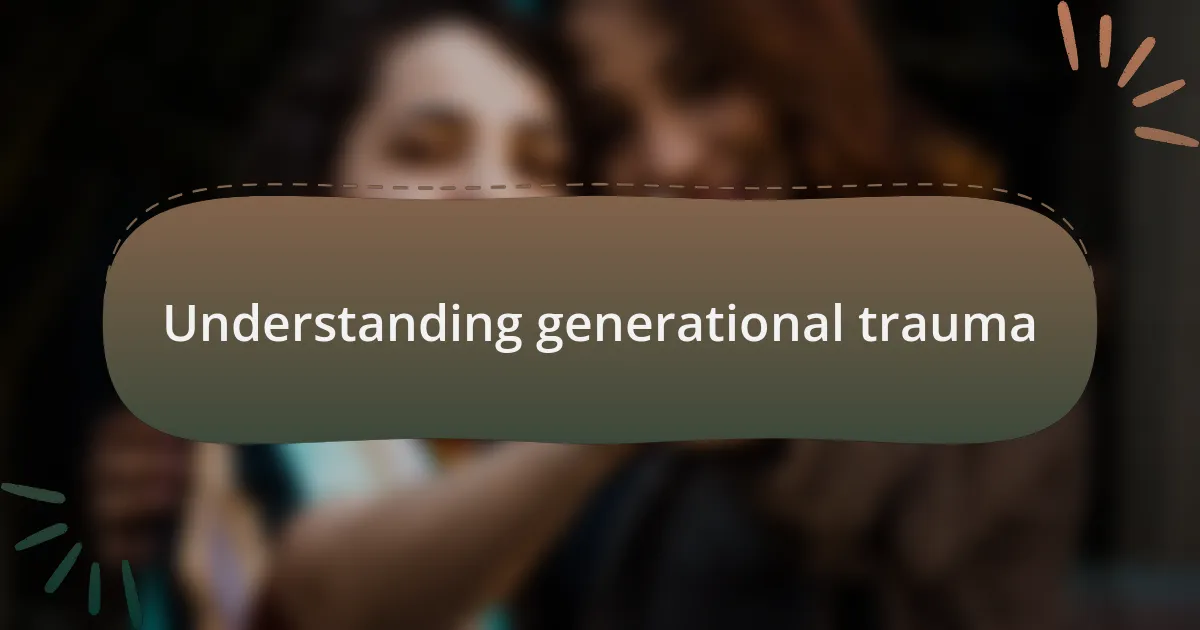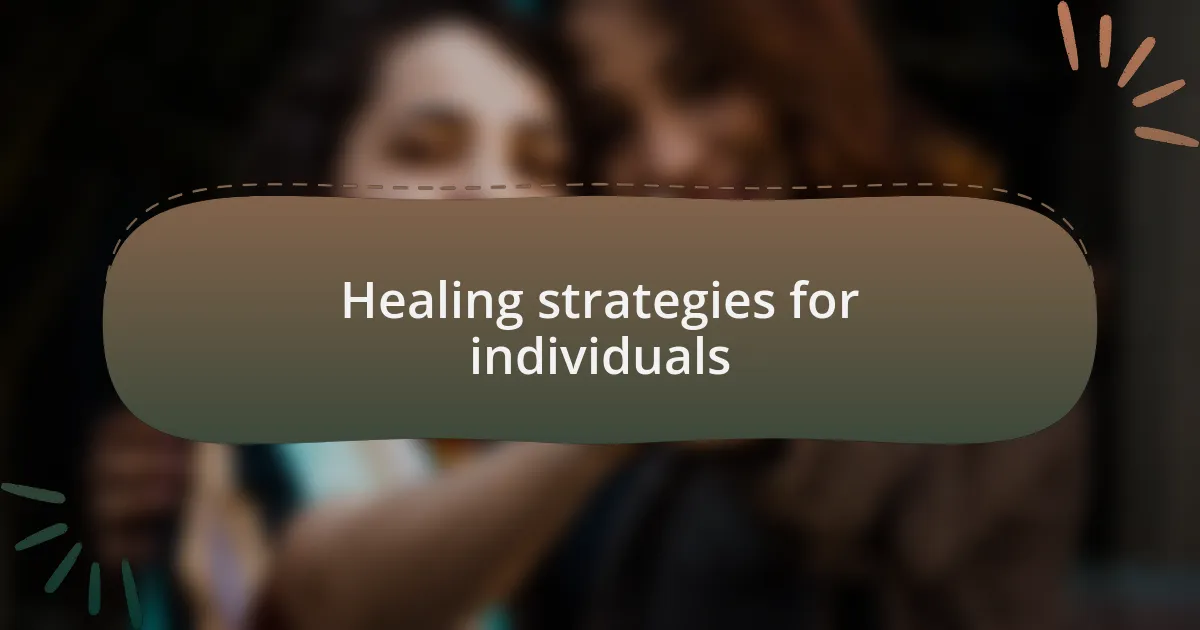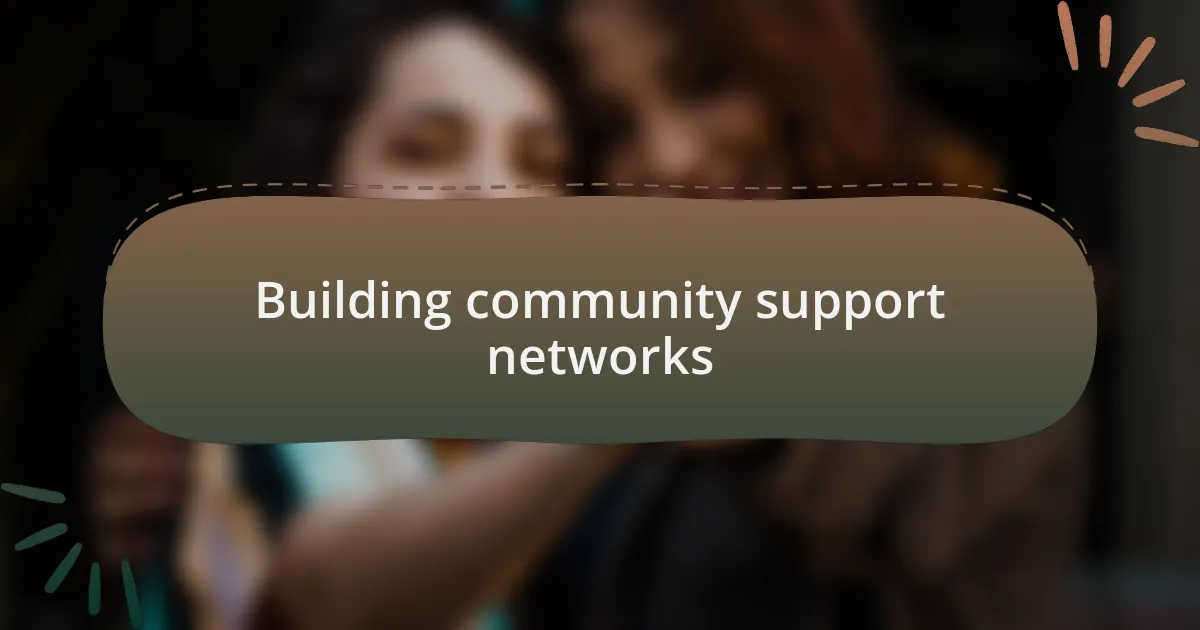Key takeaways:
- Generational trauma influences emotional patterns and coping mechanisms across generations, affecting relationships and stress responses.
- Gender roles are shaped by past traumas, leading to unhealthy coping strategies and societal pressures that restrict authentic self-expression.
- Effective healing strategies include therapy, mindfulness, and building supportive communities that foster shared experiences and resilience.
- Advocacy for gender equality and community support networks are essential in challenging societal narratives and addressing structural inequalities.

Understanding generational trauma
Generational trauma refers to the emotional and psychological effects that past traumas, often experienced by one generation, can pass down to subsequent generations. I remember speaking with a friend whose family had endured the upheaval of war. She shared how her grandparents’ experiences shaped her parents’ attitudes toward conflict and emotional expression. It made me wonder—how often do we unconsciously carry the weight of our ancestors’ struggles?
Understanding the nuances of generational trauma can be challenging. I often find myself pondering how unaddressed pain can seep into the fabric of a family dynamic. For instance, when I reflect on my childhood, I notice patterns of fear and avoidance in my own family that seemed to reflect unresolved issues from previous generations. Have you ever recognized similar patterns in your own life or those around you?
This cycle isn’t just about the past; it influences how we navigate our relationships and cope with stress in the present. From personal observation, I’ve seen many individuals react to challenges based on the ingrained responses learned from their families, often unaware of this influence. Isn’t it compelling to think about the ways we might need to break these cycles to create a healthier future?

Impact of trauma on gender
Trauma can profoundly shape gender roles and expectations within a family. I recall a conversation with a colleague whose mother was a survivor of domestic abuse. She often spoke of the rigid gender norms instilled in her, guiding her to always prioritize others’ needs over her own. It left me to wonder how many women bear the burden of misplaced responsibility because of trauma that predates them.
For many, the impact of trauma molds how they perceive their own gender identity. I’ve spoken with individuals who felt pressured to conform to traditional masculine or feminine roles stemming from their family’s history. It’s striking to think that such pressures may stem from trauma, making me ask—how often do we stifle our authentic selves to fit inherited molds?
Moreover, the effects of trauma can lead to unhealthy coping mechanisms that disproportionately affect one gender over another. I’ve noticed in various discussions that men, often taught to suppress vulnerability, may resort to aggression versus seeking help. Isn’t it vital for us to recognize how these patterns can perpetuate cycles of pain that may trap us in unhealthy dynamics?

Gender roles and trauma dynamics
The interplay between gender roles and trauma dynamics can be incredibly intricate. I remember a dear friend sharing her experiences growing up in a household where emotional expression was seen as a weakness for men. This led her brothers to either become stoic or act out in anger. How many of us have witnessed this cycle, where trauma sets the stage for rigid performances of masculinity and femininity?
As I reflect on my own upbringing, I see how societal expectations shaped my understanding of what it meant to be a man. For instance, being taught that vulnerability is a flaw made it challenging to seek support during tough times. It raises an important question for us all: how many men feel trapped by these outdated expectations, unable to break free and embrace a more authentic version of themselves?
It’s also essential to acknowledge that trauma can amplify the disparities in how we respond to crises. Women, for example, might internalize their pain, feeling pressured to nurture others despite their own wounds. I’ve seen this firsthand in female friends who juggle caregiving with their own struggles. Isn’t it time we challenge these stereotypes and create spaces that allow everyone to express their trauma freely, regardless of gender roles?

Personal experiences with gendered trauma
The weight of gendered trauma is something I have felt in my own life. I vividly recall a colleague who faced constant ridicule for her leadership style, labeled as “too aggressive” simply because she was assertive. It struck me how deeply these perceptions are rooted in societal norms, pushing women into a corner where they feel they must either conform or face backlash.
In my experience, I’ve often felt the conflicting emotions tied to vulnerability. Growing up, opening up about my struggles was met with awkward silence or dismissal, as if being open about pain was an admission of defeat. It makes you wonder, how can we dismantle these harmful narratives to foster a more supportive environment?
Watching a close friend navigate her own battles with self-worth and societal pressures has been eye-opening. She frequently feels that her achievements are overshadowed by the belief that she should be more accommodating. It raises an unsettling question: why are we still striving for equality while reinforcing these outdated perceptions of worth based on gender?

Healing strategies for individuals
One healing strategy I’ve found effective is engaging in therapy or counseling. I remember when I first started this journey; expressing my feelings in a safe space allowed me to untangle the complexities of my experiences with gendered trauma. Therapy wasn’t just about venting; it provided tools to challenge deep-seated beliefs and replace them with healthier perspectives.
Another approach I’ve embraced is mindfulness and meditation. Initially, I was skeptical, thinking it wouldn’t make much of a difference. However, I began to notice how being present in the moment helped me to quiet the noise of self-doubt and societal expectations. This practice not only calmed my mind but also gave me the strength to confront the narratives that sought to limit my potential.
Additionally, building a community of supportive individuals has been transformative. I’ve had conversations with people who share similar experiences, and there’s something incredibly validating about that connection. It makes me question—how powerful could our stories be if we leveraged collective healing to challenge gender norms together?

Advocacy for gender equality
Advocacy for gender equality is crucial because it creates awareness about the structural inequalities that persist in society. I often reflect on how empowering it feels to stand with others in solidarity, raising our voices against injustices. When I joined local advocacy groups, I witnessed firsthand how grassroots efforts mobilize communities, driving tangible change towards gender equality.
Furthermore, it’s vital to educate ourselves and others on the nuances of gender issues. I remember attending a workshop where I learned about intersectionality—the idea that different social categorizations such as race, class, and gender overlap. This understanding deepened my empathy and guided my conversations, reminding me that everyone’s experience is shaped by multiple factors, which is essential in the fight for equality.
To create lasting impact, we must also challenge the narratives we encounter daily. I often grapple with the media’s portrayal of gender roles and how it shapes societal expectations. What if we collectively committed to reshaping these narratives? This shift could inspire a new generation to envision a more equitable world, where everyone, regardless of gender, has the opportunity to thrive.

Building community support networks
Building community support networks is a transformative step in addressing generational trauma and fostering resilience. I recall a time when I participated in a community circle, where individuals shared their stories of hardship and triumph. There was something profound about that exchange; it was as if the weight of our collective experiences lightened with each shared voice.
In my experience, these networks provide more than just emotional support—they create a safe space for healing. Have you ever felt the power of belonging? I remember looking around the room as we all nodded in understanding, reinforcing that we weren’t alone in our struggles. These connections can spark initiatives that elevate marginalized voices and promote healing from historical injustices.
Moreover, building these support systems requires active engagement and a commitment to inclusivity. It’s not just about gathering people; it’s about fostering meaningful connections that empower individuals. Through my involvement in various groups, I’ve witnessed how a small act of kindness or encouragement can reshape someone’s path. How can we better nurture these relationships to facilitate growth? I believe it starts with recognizing that everyone has something valuable to contribute to the dialogue, and every story shared strengthens our community fabric.